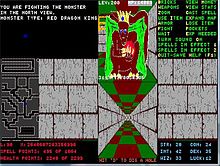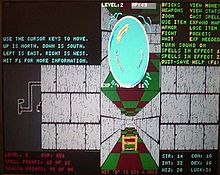- Moraff's World
-
Moraff's World
A random title screen from Moraff's World. The four most visible creatures are a Walking Sword, a Black Puffball, the strangely drawn Face of Doom and Zeus.Developer(s) Moraffware[1] Publisher(s) Moraffware[1] Programmer(s) Steve Moraff[1] Platform(s) MS-DOS Release date(s) Genre(s) Role-playing game[1] Mode(s) Single player Media/distribution Floppy Moraff's World is the second of three in a series of roguelike shareware computer games produced by Steve Moraff in the late 1980s and early 1990s. Although more advanced than its predecessor, Moraff's Revenge, it lacks the plot and "modernized" graphics of its successor, Moraff's Dungeons of the Unforgiven.
Contents
Gameplay
Like most games of its genre, the player creates a character, choosing between several different races and classes. This character will explore one or more dungeons that are 202 levels each. The level maps are constant for each floor and never change.
The player's objective is to kill monsters, gain experience, find treasures, and kill the evil Red Dragon King. The topmost dungeon level is always a monster-free town with services such as an inn for regenerating spell points, a bank for converting stones into jewel pieces (the currency in Moraff's World), shops for weapons and armor, a temple for curing, and access to the wilderness.
A map of a town in Moraff's WorldThe wilderness leads to other dungeons in Moraff's World. Since other dungeons provide only different layouts, traveling beyond the original dungeon serves little purpose. Also, the boats required to cross overland bodies of water are expensive. The wildnerness is absent in the sequel, Dungeons of the Unforgiven, where simple teleporters are used instead.
Traveling to and from dungeon levels requires locating ladders that lead to other floors. Some ladders skip a few floors for the player, and certain up ladders send a player several floors higher, but disappear after, preventing the player from climbing back down again. Alternatively, a player may use a floor "slosher" (down to level 75), use a "descend" spell (down to level 123) or, failing all else, dig through the floor (down to level 120) to go down a level. There are also "ascend" spells to go up, although they only work down to the 64th level. When traversing a ladder, monsters do not get a free strike, so ladders can provide refuge for casting healing spells or, if the character has a ring of regeneration, regaining hit points by waiting around. Chutes are a one-way means of traveling down if the character steps on one. They are hidden, but are revealed in any explored squares when the player leaves the level.
Combat in the dungeons is turn-based. One of the distinctive features of all of Moraff's RPGs is that the main screen is divided into four mini-screens that allow the player to view creatures and hallways in all directions (but also allow them to be attacked by up to four different creatures in open spaces). Damage is dealt through standard RPG rolling systems and checks (i.e. armor class, weapon strength).
Although all monsters die when they hit zero hit points, the character must go below zero in order to die. When the character dies, he immediately rises from the dead (with a loss of one point of constitution) if in possession of a raise dead contract with a town temple.
Bosses
At eight key depths in the game are bosses who are more powerful than the average enemy for the level. When defeated, each of these monsters drops a power item to enchant weapons and armor and generally toughen up the player's character. Once the final boss, the Red Dragon King on dungeon level 200, has been defeated, the player may continue with the game, but this is somewhat pointless as the player has defeated the most powerful creature Moraff has to offer.
Character classes and race
The first task for a player is to choose a race. There are eight different races to choose from, each with their own strengths and weaknesses, and with the human being the "average" race (i.e. all statistics are equal). The other seven classes are elf, dwarf, hobbit, gnome, ogre, sprite and imp. Each race's attributes are more or less the traditional ones; for example the Ogre is strong, but stupid and the Imp is intelligent, but weak. Unlike in Moraff's Revenge, the player's choice of race has a significant impact on gameplay.
There are seven classes to choose from, each listed below with their in-game description:
- Fighter: Simple to play, can use many weapons, no spells and very little magic. Should have high strength, agility, constitution. Cannot use spellbooks, at all.
- Worshiper [sic]: Very poor fighter. Can cast many priestly spells. Interesting to play, but requires very peaceful attitude. Can use all priest, permanent, and preparation spellbooks, gains more spell points then a priest at level up.
- Monk: Doesn't use weapons, can't keep any items, magic or not. Deadly with hands, and has ability to cast spells without spellbooks. Note: Can actually keep a small number of the special items you get as boss rewards and random finds; starts with all spells, but gains manna like a fighter (so virtually no spell points to cast spells with)
- Wizard: Doesn't fight well but gets more spells than any other class. Should have very high intelligence. Good for advanced players. Note: The above is a description of what the game SAYS, in reality the Wizard gets more spell POINTS then any other class, but cannot cast priestly spells (like the hugely important protection from level drain). Can use all wizard, permanent, and preparation spellbooks. Can only equip knife and robes.
- Priest: Moderate fighter with many defensive and subtle spells. Should have high wisdom, but all characteristics are important. Can equip up to field plate armour, can use all priest, permanent, and preparation spellbooks.
- Sage: Poor fighter, poor spell caster. Good for exploring without being noticed. Gains experience just for exploring. Needs high agility. This class must be played very carefully. Not for beginners. Note: The above is a description of what the game SAYS, in reality the Sage does not gain experience for exploring, but CAN use weapons and items (unlike the monk) AND can learn all spells in the game. Can equip knife, and leather armour, can use all spellbooks
- Mage: Combination of fighter and wizard. Very hard to start, but very powerful later. Needs well-balanced characteristics. Less spell points then wizard, can use the second best sword, and second best armour (longsword and field plate), can learn all wizard, preparation, and permanent spells
The classes are fairly self-explanatory. It is useful to note which classes can use which types of spellbooks, weapons and armor, most notably that the Mage cannot wield the Greatsword or the strongest form of armor.
Monster types
There are more than 40 different monsters to be found in Moraff's World, who fall into several different classes.
Regular monsters
This group includes Walking Swords, Dwarves, Armored Fighters, Ogres, Kobalds [sic]), Apes and Orcs. These monsters are fairly common and don't possess any particularly unique traits, save for that they are plentiful and dangerous on lower levels.
Some regular monsters, such as Foot Stompers, Faces of Doom, Unicorns, Titans and Stone Golems are crudely drawn and far less common, although they have no special traits. One such creature, the Flesh Eater, became the basis for Moraff's Escapade.
Blockers
This group includes Giant Colored Balls and Garbage Can Men. While having no unique characteristics in and of themselves, they often have massive amounts of hit points (up to 32000 on the lower levels), making them extremely tedious (and dangerous if there are other monsters around) to kill if the character cannot use an Autokill spell.
Puffballs
Puffballs come in many different colors and possess exceedingly low hit points, even on lower dungeon levels. If a puffball is not killed within a few rounds, it will raise or lower one character attribute and disappear. Like the magic pills found in Moraff's World, each distinct color of puffball affects a specific character attribute. A general rule is that if the puffball is "light", it will raise an attribute, whereas if it is "dark", it will lower it.
Poisoned and diseased monsters
Poisoned and diseased monsters are regular creatures that have been painted black (in the case of poison) or green (for disease). Creatures of this type include Giant Ants, Spiders, Bats and Scorpions. Poison drains strength after a certain number of rounds, while disease drains constitution. There are also yellow versions of all these creatures which function as regular enemies.
Dragons
This category includes Dragonflies, Mini and Major Dragons and Dragon Kings. Orange and Blue breathe fire and ice respectively, which does a large amount of damage with no after effects. Black and Green function as poisoned and diseased creatures, while White can spray acid that will melt the character's current armor. The Shadow dragon series mentioned above is difficult to hit with physical weapons, whereas the Reds drain levels with every attack.
Level drainers
Level drainers are undead creatures that, as the name implies, drain the player's level with every hit. When killed, they drop different colored pills that raise and lower statistics and keys that allow access to the level-skipping trapdoor system. The trapdoor system is crucial at levels below 64, where conventional means of level skipping do not work. The level drainers include Zombies, Medusa, Skeletens [sic], Wraiths, Spectors [sic], Demons, Mummies, Vampires and Ghouls.
Superbeings
Zeus and Devil are the two superbeings to be found in Moraff's World. They are exceedingly rare (until you pass the 175th level then they become more common), but also incredibly dangerous. They have a high number of hit points, powerful spells and attacks, and cannot be killed with Autokill, or even the Holy Hand Grenade. These monsters, along with the bosses, are also immune to the "Go Away" and "Drain Monster" spells. The Devil is especially dangerous, because he is also a level drainer who takes away three levels with every hit. The Devil is almost impossible to defeat, unless you are a Priest and have the Resist Drain Level spell, or have a Scroll of the same spell.
See also
- Bard's Tale, the video game that was the inspiration for this game
References
Other sources
- "Moraff's Games". RPGDot. Archived from the original on September 28, 2007. http://web.archive.org/web/20070928101538/http://www.rpgdot.com/index.php?hsaction=10053&ID=82&sid=cf00398949a9d3f0b92cf0a1d835376a. Retrieved September 8, 2005. (Inactive as of November 17, 2010)
- "Moraff's World". Home of the Underdogs. Archived from the original on September 29, 2007. http://web.archive.org/web/20070929150552/http://www.the-underdogs.info/game.php?id=2513. Retrieved April 21, 2006. (Inactive as of April 16, 2009)
Categories:- 1991 video games
- DOS games
- First-person adventures
- North America-exclusive video games
- Roguelikes
- Video game sequels
Wikimedia Foundation. 2010.




